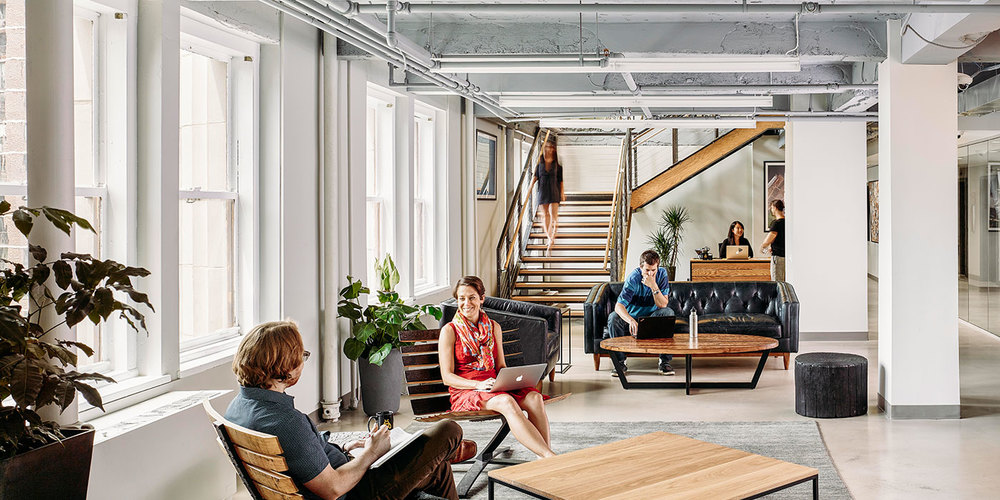Pictured above: Dream Office REIT’s Scotia Plaza Headquarters Designed by figure3. (Photohrapher: Steve Tsai)
On Tuesday, professionals from the architecture, design and commercial real estate field gathered to discuss the Future of Work. Hosted by Bisnow at the Ritz Carlton in downtown Toronto, an expert panel discussed the challenges and opportunities ahead for the workplace.
The Panel was moderated by CBRE’s Managing Director of Workplace Strategy, Lisa-Fulford Roy. Panelists included: Tyler Gilchrist, Design Research and Strategy Leader, figure3; Debbie Baxter, VP, Real Estate Advisory, and National Leader, Work+Place, Deloitte; Kevin Hardy, SVP, Dream Office REIT and Scott Watson, Partner, Crown Realty Partners.
HOK’s Kay Sargent’s opening remarks alluded to an ongoing theme of the what the future of work holds – a focus on people. Sargent highlighted that while 80% of a company’s costs go toward people, 70% of employees are disengaged”. As organizations shift focus to engaging their workforce, the workplace will play an important role in creative positive employee experiences.
Engaging design will take the employee experience to heart. The future of work will be one based around people.
Technology is Shaping the Workplace

Deloitte’s Edge in Amsterdam, the building is a combination of technology and flexible working that enhances the employee experience (Photographer Stijn Poelstra)
Deloitte’s Debbie Baxter opened by describing the future of work as having two main components: technology and generational impacts. “Technology is becoming such an innate part of our world and therefore the nature of work has to change” explained Baxter.
Secondly, the Deloitte VP believes that Gen Z will have a much greater impact than Millennials on the workplace. It’s because of Gen Z’s relationship with technology. Having grown up with smartphones and a variety of online media and apps always available, the work environment will have to adapt to meet the needs of Gen Z.
With regards to technology, machine learning and artificial intelligence in the workplace were cited as having the most disruptive potential. But the impact these technologies will have is highly unclear. What was more apparent was the uncertainty that technology has introduced into the workplace.
Future Proofing
Future proofing becomes even more important as a result of advancements in corporate and consumer technology. Tyler Gilchrist noted that at the pace of technological innovation, a firm’s project may be obsolete by the time that construction is completed. This is because layouts may no longer make sense for the way that people work, or a business is organized.
Gilchrist observed that future proofing is about anticipating multiple possible scenarios and building enough flexibility into a space. This allows a workplace to adapt to which ever reality manifests itself.
The sentiment of flexible environments for future proofed spaces was shared by others as well. Baxter explained that companies are taking unique approaches to create flexibility. Traditionally, uncertainty combined with inflexibility in longer term real estate commitments have been a challenge. Some large firms are now looking to coworking spaces to provide this type of flexibility they previously lacked.
Flexibility and Choice
Even within traditional spaces, organizations are looking to provide more flexibility by moving away from individual private areas and moving towards unassigned seating. One example is Deloitte’s new Toronto office where even the CEO doesn’t have an office.
Fulford-Roy explained that the role of physical space has changed. As a result, where the workplace may have previously consisted of 80% individual spaces and 20% collaborative areas, we’re seeing it shift to more of a 50-50 ratio. Eventually, Lisa notes, we may see a shift to 80% collaborative spaces and 20% individual ones.
The move away from individual spaces provides more variety in the workplace. It’s a benefit that allows people to fine tune their work environment to certain personal traits. Different types of work spaces can meet the needs of different generations or even introverts vs extroverts.
For those used to working a typical 9-5 at their desk the idea of working in an onsite café or from a couch in a collaborative area may seem foreign. Crown Realty’s, Scott Watson acknowledge that more flexibility and unassigned seating will be a challenge for some employees. For them, he explains, it’s important to communicate a changing culture. There’s a need to let employees know “Its okay to work differently”, we’re not all the same.
Multigenerational Offices

Dream’s Scotia Plaza Headquarters (Photographer: Steve Tsai)
While all employees aren’t the same, it’s important not to lose sight of shared values in multigenerational workforce.
Gilchrist noted that it’s easy to get caught up in generational differences rather than looking at commonalities. He highlighted the need to go back to looking at employees from the human level. Designing for people based on their human needs, through human centric design allows for the greatest benefits to be achieved that can meet the needs of an entire workforce.
Dream Office REIT’s Kevin Hardy supported features that address the needs of many employees. He used Dream’s new Scotia Plaza office as an example. Kevin explained that the changes, which included removing perimeter offices to increase natural light were embraced by employees of all ages. Features like increased natural light benefit everyone from a simple physiological standpoint.
The Future of Work
Future proofing is more about remaining adaptable than being able to predict the next trend correctly. A mix of effective technology, flexibility and choice will be required to deliver a better work experience to employees. Finally, no matter what the future of the workplace looks like, basic human needs are shared by all employees, regardless of generation.




